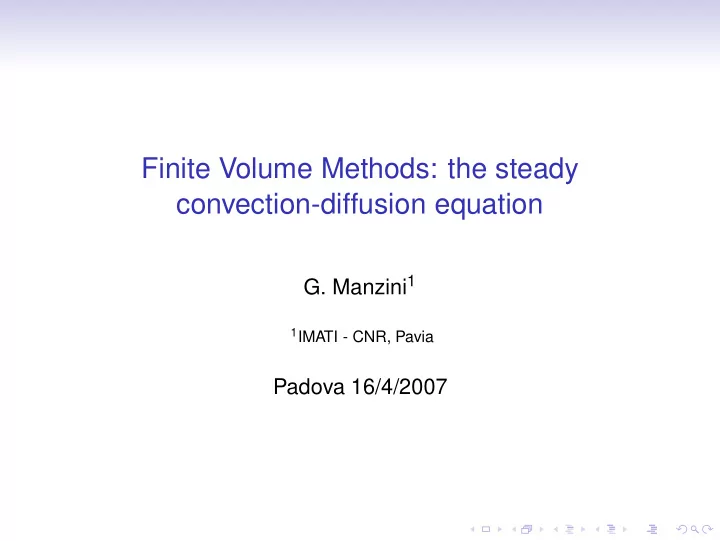

Finite Volume Methods: the steady convection-diffusion equation G. Manzini 1 1 IMATI - CNR, Pavia Padova 16/4/2007
R 2 , The reference problem • Steady convected-dominated diffusion-transport problems are ruled by the following equation: Find a function u ( x ) such that div ( β u − ν ∇ u ) = G , in Ω ∈ u = g D , ∂ Ω D , on n · ν ∇ u = g N , ∂ Ω N . on • Challenging/interesting cases: | β | > > ν ν → 0 , or (almost equivalently) the very big issue is calculation of layers (steep gradient regions)!
The one-dimensional case Let us consider β u ′ − ν u ′′ = 1 , x ∈ ( 0 , 1 ) , for u ( 0 ) = u ( 1 ) = 0 for β, ν ∈ R + . From the differential equation, we expect that: • for very small values of ν , i.e ν < <β , the second derivative term ν u ′′ is negligible in a large part of the domain ( 0 , 1 ) = ⇒ u grows almost linearly far from x = 1, i.e. u ( x ) ≈ 1 /β ; • an abrupt decrease of u, the boundary layer , occurs near x = 1 because u must reach zero at this boundary point. The behavior of u for x close to 1 is governed by the second derivative.
The one-dimensional case: exact solution u ( x ) 1 � � x − 1 − e β x /ν u ( x ) = 1 β 1 − e β/ν β = 1 0.8 1 /ν = 100 0.6 1 /ν = 10 0.4 0.2 1 /ν = 1 0 0 0.2 0.4 0.6 0.8 1
The exponential layer calculation Y 1 0 1 X This is what we want to approximate.
The exponential layer calculation Y 1 �� �� �� �� � ������ � ������ �� �� � ������ � ������ � ������ ������ � � � ������ ������ � ������ ������ � ������ � ������ � ������ � ������ � �� �� � ������ ������ � �� �� � ������ ������ � �� �� � � � � ������ ������ � � ������ ������ � � � � � ������ � ������ � � ������ � ������ � � � � ������ � ������ � � ������ ������ � � �� �� � � ������ � ������ � �� �� � � ������ � � ������ �� �� � � � � � ������ � ������ �� �� � � � � � ������ ������ � � � � � � � ������ ������ � � � ������ ������ � � � � � � � ������ ������ � � � � � � ������ � ������ � � � � � � ������ � ������ � � �� �� � � � ������ ������ � � � �� �� ������ ������ � � � � � � �� �� � � � ������ � ������ � � � � � � � � ������ � � ������ � � � � � � ������ � � ������ � � � � � � � ������ � ������ � � � � � ������ ������ � � � � � � � � ������ ������ � � � �� �� � � � � � � � � ������ ������ � � � � �� �� � � � � � � ������ ������ � � � � �� �� � � � � � � ������ ������ � � � � � � � ������ � ������ � � � � � � ������ � � ������ � � � � � � � � � � � � � � ������ ������ � � � � � � � � ������ � � ������ � � � � � � � � � ������ � ������ � � � � � � ������ � ������ � �� �� � � � � � � ������ � ������ � �� �� � � � � � � � � � � � � � � � ������ ������ � �� �� � � � � � � � � � � ������ � � ������ � � � � � � � � � � ������ � ������ � � � � � � � � � ������ � ������ � � � � � � � � � � ������ � ������ � � � � � � � � � � � � � � ������ ������ � � � � � � � � � � � � ������ � ������ � � � � � � � �� �� � � � � ������ ������ � � �� �� � � �� �� � � � � � � ������ � � ������ �� �� � � �� �� �� �� 0 1 X Sketch of a nodal approximation that we would like to see.
Recommend
More recommend